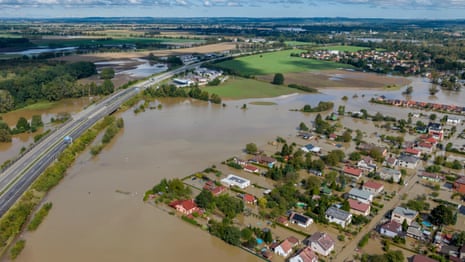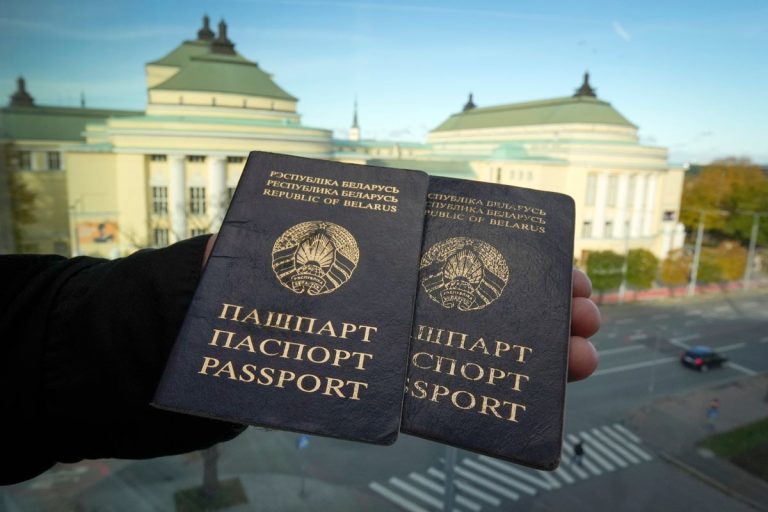Central Europe braces for further flooding as swollen rivers continue to rise | Extreme weather

As swollen rivers continued to rise, volunteers and emergency workers in towns and cities across a swathe of central Europe were reinforcing defences against floods that have killed at least 18 people in four countries.
Storm Boris has dumped up to five times the average September rainfall on parts of Austria, the Czech Republic, Hungary, Poland, Romania and Slovakia in four days, submerging entire neighbourhoods and forcing hundreds of thousands to evacuate.
Seven people have died in Romania, four in Poland, four in Austria and three in the Czech Republic, according to officials, with several missing. While the rain was easing in some areas, water levels in others were not expected to peak for several days.
The Danube River was still rising in Slovakia and Hungary, with streets in parts of Bratislava’s old town already flooded and emergency mobile dams moved into place at the historic towns of Visegrád and Szentendre, north of Budapest.
Torrential rain and flooding hits central and eastern Europe – video report
In the Hungarian capital, the river was rising by about a metre every 24 hours, Budapest city hall said. Tram lines and roads alongside the river, as well as the popular Margaret island, have been closed to the public and a million sandbags offered to residents.
Authorities to the east, in eastern Germany, were also taking precautions, with mobile flood protection walls set up in some areas to protect Dresden’s old city as the Elbe River rose steadily. The river was expected to peak by midweek.
Extreme rainfall is becoming more common and intense because of human-caused climate breakdown across most of the world, particularly in Europe, most of Asia, central and eastern North America, and parts of South America, Africa and Australia.
Firefighters fill bags with sand to reinforce the flood protection in Jelenia Góra, Poland. Photograph: NewsLubuski/East News/Rex/Shutterstock
The climate emergency is causing more incidents of extreme rainfall because warmer air can hold more water vapour. Other human factors, such as flood defence planning and land use, are also important factors in consequent flooding.
Near the border between Poland and the Czech Republic, one of the hardest-hit areas, 2,000 volunteers from the Polish town of Nysa’s population of 44,000 spent Monday night helping rescue workers build up a burst river embankment.
“Please evacuate your belongings, yourselves, your loved ones. It is worth getting to the top floor of the building immediately, because the wave may be several metres high,” the town’s mayor, Kordian Kolbiarz, had told residents on Monday night.
Continuous rain has caused severe damage in parts of the Czech Republic. Photograph: Action Press/Rex/Shutterstock
On Tuesday morning, the mayor said on Facebook that “women, men, children and the elderly” had come out to try to save their town. “We simply … did everything we could,” Kolbiarz wrote on Facebook. “We fought for Nysa. Our home. Our future.”
Wrocław, about 56 miles (90km) to the north and home to 600,000 people, was also preparing for the water level in the Odra (Oder) River to peak on Friday, or perhaps sooner. Firefighters and soldiers reinforced embankments with sandbags.
The city zoo, alongside the river, appealed for volunteers to fill sandbags on Tuesday morning. “We and our animals will be extremely grateful for your help,” it said.
A huge reservoir near the border aimed at reducing water levels and preventing flood waters from the Odra and Nysa from merging – as they did in catastrophic flooding in 1997 – was about 75% full, authorities said.
skip past newsletter promotion
Sign up to This is Europe
The most pressing stories and debates for Europeans – from identity to economics to the environment
Privacy Notice: Newsletters may contain info about charities, online ads, and content funded by outside parties. For more information see our Privacy Policy. We use Google reCaptcha to protect our website and the Google Privacy Policy and Terms of Service apply.
after newsletter promotion
The aftermath of a burst dam in the Polish town of Kłodzko. Photograph: Action Press/Rex/Shutterstock
Poland’s prime minister, Donald Tusk, on Monday announced an emergency relief fund of 1bn złotys (€200m) for flood victims in the country, adding that Poland would apply for EU relief funds.
In the Czech Republic, the prime minister, Petr Fiala, said more than 13,000 people had been evacuated and tens of thousands of households were still without power. Eight people in the country were still unaccounted for as a result of the storm.
In the eastern city of Krnov, people were beginning to cart away debris on Tuesday. “All the pavements are destroyed, everything’s toppled, everything’s broken … It’s a nightmare,” Eliska Cokreska, 76, told Agence France-Presse.
The fire service delivered bottles of drinking water to villages cut off by the floods, with residents warned not to drink tap water as it would be heavily contaminated.
Many houses and streets remain underwater in Hadersdorf am Kamp, Lower Austria. Photograph: Action Press/Rex/Shutterstock
In Austria, the state of Lower Austria has been declared a disaster zone. The flooding has broken a dozen dams, with muddy rivers raging through devastated villages and thousands of households without electricity and water.
In the Austrian town of St Pölten, more rain has fallen in four days than in the whole of the wettest autumn on record 75 years ago. The army has been deployed across the region and a €300m emergency fund made available.
Weather in the region is expected to improve steadily from late on Tuesday, but Storm Boris is forecast to move to northern Italy, where the region of Emilia-Romagna is bracing for the impact of 100-150mm of rainfall.
Reuters, Agence France-Presse and Associated Press contributed reporting






